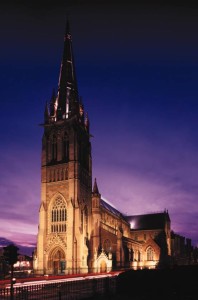











 The significance of St. Peter’s is based on four main criteria – historical, social, cultural and architectural. Since the early nineteenth century, in the early years following Catholic Emancipation, the site has been used to serve the spiritual and educational needs of the Catholic community. These functions, the sequence of buildings that served them and the clergy who ministered from them, have had a significant affect on the development and the physical and social improvement of the surrounding area. The church also occupies a prominent, elevated site between the North Circular and Cabra Roads that creates long vistas from the east, making the tower and spire one of the most memorable landmarks in the city. Many prominent figures in Irish political and ecclesiastical society, including Daniel O’Connell and Archbishop William Walsh, have been associated with the various building programmes over the years, which further enhances the social and historical significance of the place.
The significance of St. Peter’s is based on four main criteria – historical, social, cultural and architectural. Since the early nineteenth century, in the early years following Catholic Emancipation, the site has been used to serve the spiritual and educational needs of the Catholic community. These functions, the sequence of buildings that served them and the clergy who ministered from them, have had a significant affect on the development and the physical and social improvement of the surrounding area. The church also occupies a prominent, elevated site between the North Circular and Cabra Roads that creates long vistas from the east, making the tower and spire one of the most memorable landmarks in the city. Many prominent figures in Irish political and ecclesiastical society, including Daniel O’Connell and Archbishop William Walsh, have been associated with the various building programmes over the years, which further enhances the social and historical significance of the place.
While St. Peter’s is today the product of several different phases of development and remodelling carried out over a number of different eras, it is a testament to the skill and craftmanship of its architects – Weightman, Hadfield, Goldie and Ashlin & Coleman – that the church has evolved as a unified and powerful architectural entity amongst the best of its period, to be found in Dublin. Both architectural firms were prominent leaders in church architecture and built ecclesiastical buildings of high quality. Their work at St. Peter’s is no exception. In particular Ashlin & Coleman’s dramatic and prominent spire can be said to be significant not only for its architectural qualities but also for its urban design qualities and unambiguous symbolic function it performs.
Its long association with the adjacent presbytery, a fine example of the Carpenter Gothic style, adds to its interest and enhances the social value of the site that educated many in the local community, beginning in the early nineteenth century.
The internal spatial arrangement and furnishings are also of high quality, in particular the stained glass windows. Many of these are from the studio Lobin of Tours and are of high quality, while those of the Irish stained glass master Harry Clarke are of international cultural significance.
All of these various strands of interest and built heritage can be said to combine to make an historic place of regional significance.